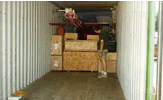Container Packing Tips
 General Packing Tips:
General Packing Tips:
- Personal items should be wrapped and packed into strong cardboard moving boxes or bins.
- Number your boxes and label with your name, address and telephone numbe.
- Reinforce the bottom of all boxes with plenty of tape.
- Fill each box to its capacity using fillers to fill any empty spaces.
- Try to use original shipping boxes for computers, printers and other electronic items when possible.
- Large items such as furniture, etc should be wrapped with proper padding for protection.
- All appliances should be clean and dry. Immobilize moving parts and remove all detachable cords and wires. Tape electrical cords to the appliance and tape all doors and lids closed.
- Drain all gasoline and oil from lawn mowers, chain saws and other equipment.
- Disconnect all batteries. Make sure to inform us of any batteries in your cargo. Some batteries, such as lithium ion, cannot be shipped.
- Disconnect propane gas bottles/tanks. These cannot be shipped.
- Strap long garden tools together.
- The following personal possessions cannot be shipped: poisonous, flammable, corrosive, perishables, fuels, cleaning chemicals, insecticides, food, drugs, firearms, ammunition, animals, alcohol, tobacco and perfume products.
- Irreplaceable or valuable items should not be shipped such as original documents (birth certificates, passports, etc), videos (wedding, etc) and jewelry.
 Tips to consider when packing your own container:
Tips to consider when packing your own container:
- The container will arrive on a chassis and consequently sit approximately four feet off the ground.
- It is the responsibility of the shipper to acquire approval from local authorities and/or building management for positioning of the container and chassis at the address provided.
- It is the shipper’s responsibility to confirm the space at the address provided is sufficient and safe enough to accommodate the positioning of a container on a chassis. However it is ultimately the transporters discretion to cancel the positioning of the container should the area be deemed unsafe or unacceptable for loading purposes.
- All your cargo should be properly packed, staged and ready for loading prior to the containers arrival.
- You will be provided one to two hours in which to load your container. Should the loading of the container take longer than the allotted free time, a fee of approximately $95.00 will be incurred for each additional hour of waiting time.
- When shipping an automobile and personal effects in the same container, your personal effects must be loaded first.
- Make certain to load your personal effects so all is secured to avoid any movement within the container.
- Once the personal effects are securely loaded into the container a “wall” should be built composed of two sheets of plywood to protect your personal cargo.
- After installing the plywood “wall” several 2 by 4’s should be placed in front of the wall and hammered down in the ribs of the container for extra security. Since the container is 8’ wide please be reminded to cut the 2 by 4’s slightly shorter than eight feet.
- After your personal cargo is properly loaded your vehicle can then be loaded. The vehicle must be the last thing to load into your container. As per U.S. Customs regulations, there cannot be any cargo placed between the vehicle and the door of the container.
- To load the vehicle you will need a flatbed truck to raise your vehicle to the height of the container floor.
- When loading your vehicle into the container, the battery must be disconnected.
- The battery and the connectors must be wrapped with insulated tape.
- The gas tank must be empty of fuel. The vehicle should be driven until it stalls.
- Each wheel of the vehicle must be braced with wooden blocks which are nailed into the floor of the container.
- The vehicle itself must be secured by proper straps at all four points directly to the rings on the bottom of the sides of the container.
- A document will need to be signed confirming all the above steps have been performed on the vehicle.
- It is imperative that your vehicle and household goods, when loaded into the container, are soundly secured to avoid any movement within the container and that the container is loaded in a balanced manner.
- If you are uncertain of your ability to perform the above steps it is strongly suggested you consider hiring local laborers/carpenter to perform the blocking and bracing of your cargo.
